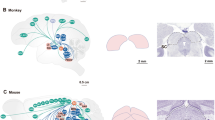Summary
The morphology of the hippocampus of Mongolian gerbils was investigated by light and electron microscopy after 5-min forebrain ischemia and survival times of up to 10 months. After 3 weeks recirculation only 5.8% of pyramidal neurons of the CA1 (cornu ammonis 1) sector had survived but the thickness of the inner and outer hippocampal layers did not change. After recirculation times of 6 and 10 months the number of surviving neurons declined no further but all layers of the CA1 subfield shrank markedly. Ultrastructurally, many but not all surviving CA1 neurons were altered. After 3 weeks both “dark” and “pale” type neurons were present, while after 6 and 10 months only the “pale” type of injury persisted. Axonal enlargements and myelin breakdown were observed at all survival times up to 10 months of recirculation. The astrocytes of CA1 sector contained numerous glial fibrils which were most pronounced after the longer recirculation times. The stratum radiatum presented intact presynaptic terminals densely packed with an abundance of clear vesicles even after survival of 10 months. Initially, morphologically damaged postsynaptic structures were still attached to these terminals but they disappeared after longer recirculation times. However, even after 10 months some intact synapses were observed involving dendrites which probably originated from surviving CA1 neurons. In CA3 sector and dentate gyrus no ultrastructural changes occurred at any survival time. The close association of surviving CA1 neurons with intact presynaptic terminals and reactive glial cells may be of importance for the development of epileptogenic foci which are characteristic of this particular brain region.
Similar content being viewed by others
References
Benveniste H, Jorgensen MB, Diemer NH, Hansen AJ (1988) Calcium accumulation by glutamate receptor activation is involved in hippocampal cell damage after ischemia. Acta Neurol Scand 78:529–536
Bodsch W, Takahashi K (1985) Molecular events associated with protein synthesis inhibition in hippocampal neurons leading to neuronal death. J Cereb Blood Flow Metab [Suppl] 5:281–282
Brierley JB, Graham DI (1984) Hypoxia and vascular disorders of the central nervous system. In: Adams JH, Corsellis JAN, Duchen LW (eds) Greenfield's neuropathology, 4th edn. John Wiley & Sons, New York, pp 125–207
Cheung JY, Bonventre JV, Malis CD, Leaf A (1986) Calcium and ischemic injury. N Engl J Med 314:1670–1676
Ito U, Spatz M, Walker JT, Klatzo I (1975) Experimental cerebral ischemia in mongolian gerbils. I. Light microscopic observations. Acta Neuropathol (Berl) 32:209–223
Johansen FF, Jorgensen MB, Diemer NH (1983) Resistance of hippocampal CA-1 interneurons to 20-min transient cerebral ischemia in the rat. Acta Neuropathol (Berl) 61:135–140
Johansen FF, Jorgensen MB, von Lubitz DKJE, Diemer NH (1984) Selective dendrite damage in hippocampal CA1 stratum radiatum with unchanged axon ultrastructure and glutamate uptake after transient cerebral ischaemia in the rat. Brain Res 291:373–377
Kirino T (1982) Delayed neuronal death in the gerbil hippocampus following ischemia. Brain Res 239:57–69
Kirino T, Sano K (1984) Fine structural nature of delayed neuronal death following ischemia in the gerbil hippocampus. Acta Neuropathol (Berl) 62:209–218
Kirino T, Tamura A, Sano K (1986) A reversible type of neuronal injury following ischemia in the gerbil hippocampus. Storke 17:455–459
Kirino T, Tamura A, Sano K (1989) Persistent presynaptic terminals in the hippocampal CA1 sector following ischemic neuronal loss. J Cereb Blood Flow Metabo [Suppl 1] 9:554
Kitagawa K, Matsumoto M, Sobue K, Niinobe M, Isaka Y, Kimura K (1989) Differential vulnerability of pre- and postsynaptic sites of neurons in cerebral ischemia: microtubule-associated protein 2 and synapsin I as specific marker proteins. J Cereb Blood Flow Metab [Suppl 1] 9:4
Meldrum B, Evanos M, Griffiths T, Simon R (1985) Ischaemic brain damage: the role of excitatory activity and of calcium entry. Br J Anaesth 57:44–46
Nishikawa Y, Takahashi T, Shimada A (1989) Morphological studies on cerebral cortical lesions induced by transient ischemia in Mongolian gerbil — Diffuse and peripheral pallor of the neuronal perikarya. Acta Neuropathol 78:1–8
Paschen W, Hallmayer J, Mies G (1987) Regional profiles of polyamines in reversible cerebral ischemia in Mongolian gerbils. Neurochem Pathol 7:143–156
Petito CK, Pulsinelli WA (1984) Sequential development of reversible and irreversible neuronal damage following cerebral ischemia. J Neuropathol Exp Neurol 43:141–153
Petito CK, Feldmann E, Pulsinelli WA, Plum F (1987) Delayed hippocampal damage in humans following cardiorespiratory arrest. Neurology 37:1281–1286
Pinard E, Rigand AS, Richie D, Naquet R, Seylaz J (1987) Continuous determination of the cerebrovascular changes induced by bicuculline and kainic acid in unanesthetized spontaneously breathing rats. Neurosciences 23:943–952
Plum F, Posner JB, Troy B (1968) Cerebral metabolic and circulatory responses to induced convulsions in animals. Arch Neurol 18:1–13
Pulsinelli WA, Brierley JB (1979) A new model of bilateral hemispheric ischemia in the unanesthetized rat. Stroke 10:267–272
Scholz W (1951) Die Krampfschädigungen des Gehirns. Springer, Berlin, S1–114
Siesjö BK (1981) Cell damage in the brain: a speculative synthesis. J Cereb Blood Flow Metab 3:38–43
Siesjö BK (1988) Historical overview: calcium, ischemia, and death of brain cells. Ann NY Acad Sci 522:638–661
Thilmann R, Xie Y, Kleihues P, Kiessling M (1986) Persistent inhibition of protein synthesis precedes delayed neuronal cell death in postischemic gerbil hippocampus. Acta Neuropathol (Berl) 71:88–93
Author information
Authors and Affiliations
Rights and permissions
About this article
Cite this article
Bonnekoh, P., Barbier, A., Oschlies, U. et al. Selective vulnerability in the gerbil hippocampus: Morphological changes after 5-min ischemia and long survival times. Acta Neuropathol 80, 18–25 (1990). https://doi.org/10.1007/BF00294217
Received:
Revised:
Accepted:
Issue Date:
DOI: https://doi.org/10.1007/BF00294217




